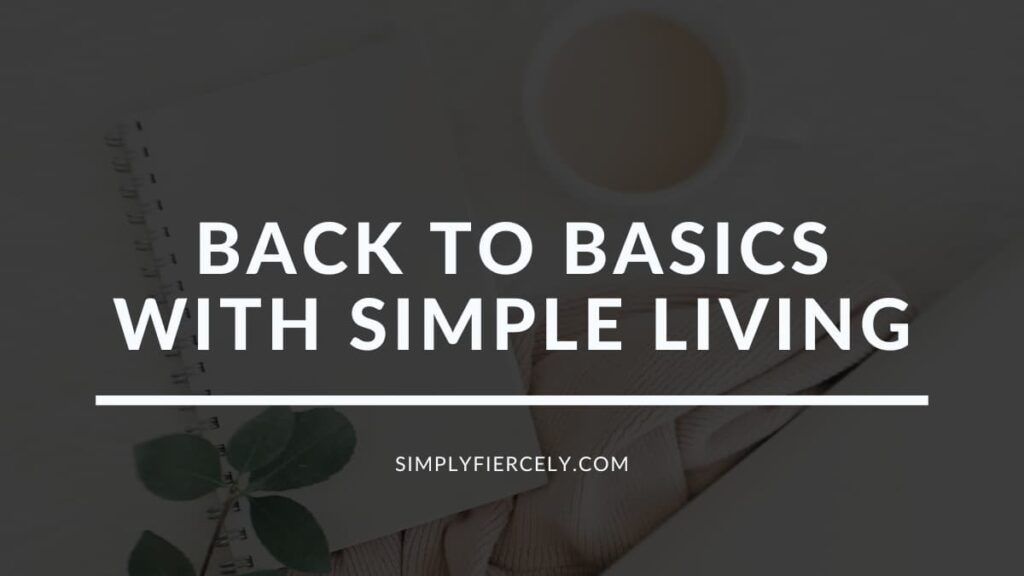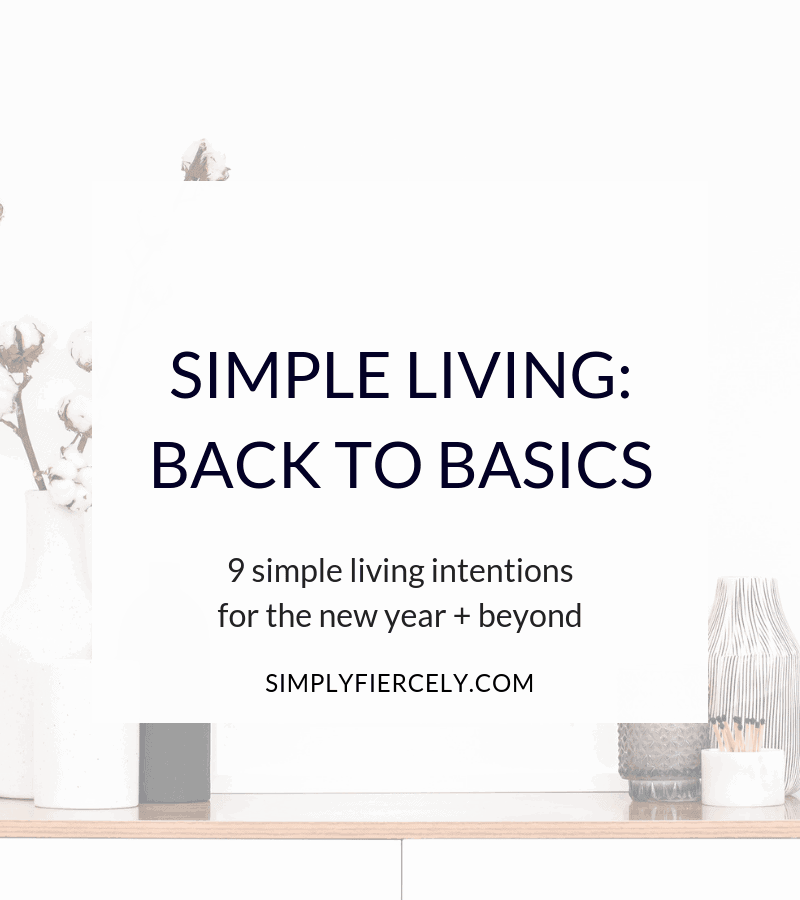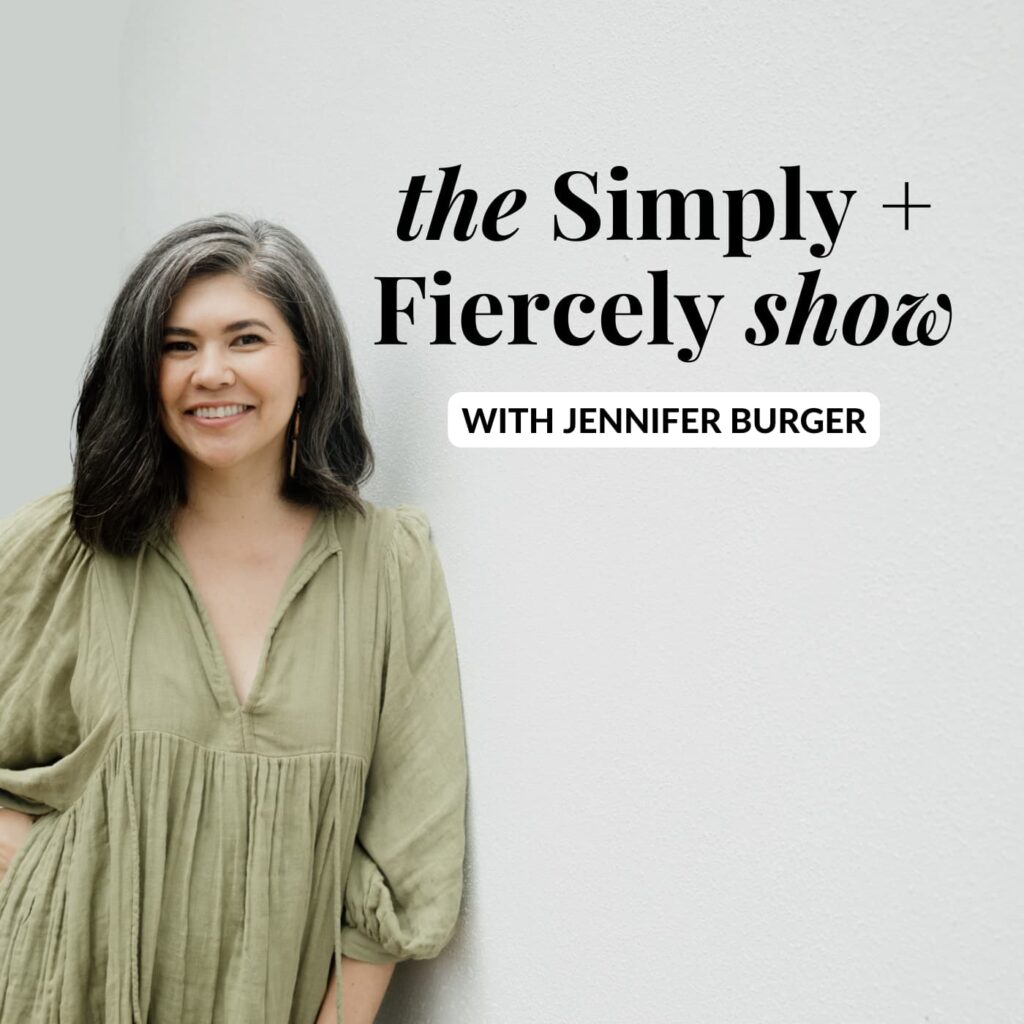Inside: when life gets busy, it’s time to get back to basics with simple living.
As a mum of two, there’s a lot on my plate, and sometimes I can feel myself losing sight of my values and priorities. When this happens, it’s a sign that I need to press the reset button.
In the spirit of essentialism, I want to take a long hard look at how I spend my time and energy and make sure that I’m laser-focused on doing the things that matter the most.
This desire comes from a deep-seated need for ease and slowness, which isn’t new, but it has grown in intensity recently. This is probably in response to the changes in my life this year; as my babies and business grow, the demands on my time and energy have increased accordingly.
This season of my life has brought new challenges, but the solutions are well known to me; no matter where we are in our lives, I believe we can all benefit from going back to the basics of simple living.

9 Ways to Get Back To Basics In Life
1. Know your values and vision
I apologise to regular readers because I know I talk about this all the time, but it’s for good reason: the cornerstone of simple living will always be knowing what matters most to you.
You must define your core values and create a personal vision if you want to live with purpose because if not, what will you use to guide you?
- When you declutter, how will you decide what to keep and what to let go?
- And when you tackle your to-do list, how will you decide what’s worth doing and what’s not?
- How can you set goals and plan for the future if you’re unclear about what you really want to achieve?
Without a clear definition of what matters, it’s hard to consistently make good decisions. (If you’ve ever found decluttering to be overwhelming, then you know exactly what I mean.) Emotions, expectations and short-term needs can cloud our judgement and make it difficult to act in our own best interest—but if you know what matters most, then you have a compass to guide you.
I already have a list of my values and a written vision (writing it down is so important!), but in the next few weeks, I’ll be revisiting them to make sure they’re still an accurate representation of what’s most important to me. If you don’t have a list, then I highly recommend creating one for yourself (and if you find it challenging, then watch this space! I’m working on a project that will help you).
RELATED POST: An Intro to Intentional Living: 7 Things You Need to Know

2. Be mindful of your mental space
I’ve found that one of the most powerful ways to create ease in your everyday life is by being mindful of your mental space. You can do this by being selective about where you focus your attention. For example, you can choose:
- not to engage in pointless arguments (especially online!)
- to log off of social media if you catch yourself mindlessly scrolling
- to limit how much news you read or watch
- to let go of anger or frustration
- not to compare yourself with other people
Note that the key to this is self-awareness; it’s not that you should never feel angry or use social media! However, you can recognise when the feeling or activity is no longer serving you and then choose to turn away for your own well-being.
RELATED POST: How To Consume Social Media Mindfully
3. Be intentional with your time
“How we spend our days is, of course, how we spend our lives.”
Annie Dillard
I love this quote, and I refer to it often because it’s a powerful reminder to be intentional with my time. Our schedules must reflect our priorities because the little things we do every day add up, and over time, they become the big things. We can either intentionally choose these “big things”, or our habits will choose them for us.
In addition, we must also consider the impact of what we do; what tasks and activities will give us the greatest return on our investment of time? I’ve struggled with this in the past and fallen into the trap of thinking everything’s important—but of course, this isn’t true, and anyway, it’s impossible to execute because we’re all limited by 24 hours in a day.
The solution is to be intentional with our time by first setting priorities in alignment with our values and then by choosing the most effective ways to move forward.
Journal Prompt: What does your schedule say about your life? If someone who didn’t know you saw your schedule, what assumptions would they make about your values and priorities?
4. Learn to say ‘no’
Of course, saying “no” is simply another way of being intentional with your time, but I wanted to highlight it as a separate item on this list because there are unique challenges; namely, when you say “no” to something, you’re usually saying “no” to someone as well.
As a people pleaser, this has been hard for me because I hate letting other people down—but I’ve come to accept that there are always tradeoffs in life. Sometimes saying “yes” to a friend or acquaintance means I’m saying “no” to my daughter, my husband or, more often, to myself. In order to have time and energy for the things that matter most, I have to (gracefully) say “no” to the nonessential.
Here are a few tips to make saying “no” easier:
- Do it quickly; the longer you wait, the harder it gets.
- Thank the other person for thinking of you
- Keep it simple; you don’t need to justify the decision to do what’s best for you
- Try exploring the below journal prompt, it will help you clarify when to say “yes” and when to say “no”.
- If you’re still struggling, watch this.
Journal Prompt: Create two lists and brainstorm how to complete the following statements: I will say “yes” if _______, and I will say “no” if _______.
5. Question the stories you tell yourself
Simple living is often associated with letting go of physical possessions and commitments, but it doesn’t stop there; we can also “declutter” our minds by questioning the stories we tell ourselves. These stories come in many forms, such as:
- self-limiting beliefs (“I could never do ___” or “I’m not a ___ type of person”)
- broad assumptions about other people (“No one here values my work”)
- stories about the future (“All I need is ___ to be happy”)
Tackling these mindsets is sometimes referred to as “next level” or “advanced” minimalism (implying that you should declutter your home and schedule first, before your beliefs), but I would argue that the reverse makes better sense. Our beliefs dictate our actions, so if our lives are cluttered, busy or complicated we need to address the beliefs that led to this state of living in the first place.
Journal Prompt: Complete the statement “I could never ___” with whatever responses first come to mind. When you’re done, write a new story; play the devil’s advocate and look for real-life examples contrary to your old beliefs.
6. Implement systems and routines
One very practical way to practice
- a morning routine
- a bedtime routine (one for my daughter and one for myself)
- a system for capturing blog post ideas and writing new posts
- an automated system for bill paying
- a cleaning routine
- a weekly planning routine
Systems and routines help me because I can rest easy knowing the most important things in my life have already been accounted for.
There are thousands of ways you can use systems and routines to simplify your life, but if you’re looking for a place to start, I recommend implementing some sort of routine for weekly planning and intention setting (this is the #1 tool that empowers me to be intentional with my time).
Related Post: 20 Ways I Simplified My Life
The Simply + Fiercely Show is a podcast for women who want to clear their clutter and create space for freedom and joy. If your life keeps getting bigger—but not better—then it’s time to declutter from the inside out. LISTEN NOW
7. Pause and reflect
Another way to simplify your life is by putting time and space between your impulses and your reactions. Here are some examples:
- Instead of making an impulse purchase, wait 24 hours and use this time to explore your motivation (is your desire to buy a genuine need, or is it an emotional reaction?)
- Before getting angry with a friend or loved one, pause and reflect on your frustration: what’s really upsetting you?
- When you feel overwhelmed with your to-do list, take a moment to step back and separate the urgent from the important.
If you’ve never tried it, I highly recommend using a journal as a tool to create this space. I’ve been journaling regularly for two years, and it has been a powerful source of positive change in my life.
RELATED POST: 7 Questions to Inspire Intentional Living
8. Declutter your physical space
Of course, I couldn’t write this post without mentioning decluttering because there’s no doubt that life is simpler with less stuff. Owning less creates physical and mental space, which in turn leads to freedom and confidence to pursue your dreams.
In my experience, the best way to declutter is to take a mindful approach. Begin by first knowing clearly what you want from your home and life, and then consciously working towards that vision by letting go of anything that doesn’t serve that vision.
I break down this method in my free guide and workbook, Mindful Decluttering. It also includes practical advice, personal stories, and a troubleshooting guide to help you overcome your decluttering challenges! I’d love for you to subscribe below and get your free copy.
9. Accept slow progress and release perfectionism
One final way to practice simple living is to accept slow progress and let go of perfectionism; in doing so, you’ll clear unnecessary stress and replace it with a feeling of ease and well-being.
Accepting slow progress means: setting realistic expectations, showing up consistently to take “small bites” out of big projects, and learning to appreciate the journey as much as the destination.
Letting go of perfectionism involves: not quitting when things don’t go exactly as planned, accepting that “good enough” really is good enough, and learning from mistakes (instead of hiding from them). I suggest you get started by working on your self-worth and practising self-kindness (click for helpful links).

Get Back to Basics with 7 Simple Days
If this post inspires you to slow down and simplify, but you feel so overwhelmed that you can’t even think about where to begin, I can help.
7 Simple Days is a mini-course that will help you press the reset button on a busy and cluttered life. In as little as one week, through simple and FUN exercises, this course will:
- bring you clarity and a better understanding of your vision and values
- help you understand what simple living really means to you
- define your priorities so you can focus on the things that matter most
- inspire you to take small, practical steps towards a life you love
- empower and motivate you to write your own story
All of this for just $29. Click here to learn more!
“Very thought provoking exercises. They really helped me to understand what I value most and take steps to make sure I’m dedicating more of my time to those things. Thanks for sharing this mini-course. It was fun, eye opening and helped with self improvement.“
– Tonya E

